SIRENS
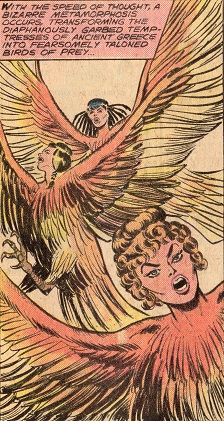
|
Classification: Humanoid extraterrestrial race
Location/Base of Operations: Formerly the Sirenum scopuli islands;
the sirens banished by Cronus are imprisoned within
a cave in the American southwest (presumably relatively close to Albequerque, New Mexico)
Known Members: Leucosia,
Ligea, Parthenope, Venus (original name unrevealed) - Pisinoe meaning ‘Persuasive Mind’
- Thelxepeia meaning ‘Soothing Words’
- Aglaope meaning 'Beautiful Face'
According
to Greek Mythology one siren played the lyre, one siren played the
flute and the third siren sang. The other names mentioned in legends
are as follows: - Aglaophonos meaning 'Beautiful Voice'
- Parthenope meaning ‘Maiden-Face’
- Leucoisa meaning 'White One'
- Ligeia meaning 'Clear Toned'
- Molpe meaning 'Music'
- Teles meaning 'Perfect'
- Raidne meaning 'Improvement'
- Thelxiope meaning 'Persuasive Face'
Affiliations: Ancient One (Yao), Ceto (mother/creator; see comments), Hera, Phorcys (father/creator; see comments), unwittingly Al and Fred, multiple unidentified bikers and soldiers they briefly controlled
a trio of Sirens were either summoned and controlled, or created, by the Huntsman (Cephalus);
possibly formerly Persephone
Enemies: Aphrodite, the crew of a pre-Atlas Foundation ship, Cronus (aka Kronos and Saturn), Ghost
Rider (John Blaze/Zarathos), Matt Ronson; presumably the Argonauts
(including Boutes and Orpheus (possibly Khoryphos)), the Muses, Odysseus and his crew,
Sersi, numerous sailors, numerous soldier, multiple unidentified bikers;
possibly Demeter
Aliases: Sirens of Kronos (on cover of Ghost Rider II#52); "Lorelei-types," (from John Blaze); "way-out chicks" (US soldier)
First Appearance: Uncanny Tales I#42/1 (April, 1956)
(Possibly creations of the Huntsman in the form of Sirens) Sub-Mariner I#29 (September, 1970);
(Sirens of Kronos) Ghost Rider II#52 (January, 1981);
(Venus/Siren) Agents of Atlas I#1 (2006)
| 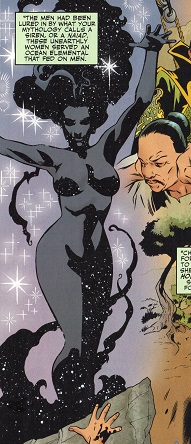
|
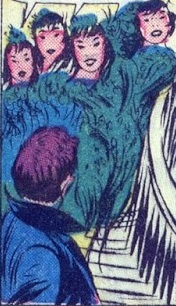
|
Powers/Abilities: The Sirens can sing in
hypnotic fashion, their voices projecting across great distances,
vocally mesmerizing those who hear their song and compelling the
listeners to follow their commands, even to the point of causing their
own deaths. Under the service of Phorcys, they commonly mesmerized
sailors, typically causing the sailors to either crash their ship into
the rocks or leap overboard to be smashed on the rocks. By seemingly
choosing these actions, the human victims were considered fair game for Phorcys to consume.
By some accounts, the Sirens were fated
to die if anyone should survive their singing.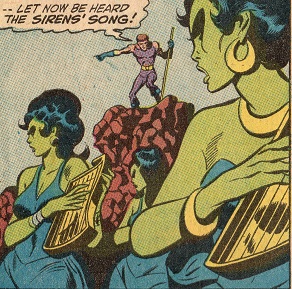
Victims could understand their speech even though they didn't speak English.
At least the trio of Sirens who encountered Ghost
Rider could transform into giant birds with human heads and fly into
the air. Their talons could presumably be used as weapons.
Some sirens appeared in mermaid form (human woman upper body, piscene lower body; see comments).
Venus the Siren was
unique
by having received a beautiful soul, so her abilities may not be
typical of the other Sirens. However, it seems likely that beyond
changing her motivations, her abilities otherwise remained the same.
Venus shares
Aphrodite’s ageless, perfect beauty and potentially limitless lifespan,
but lacks her counterpart’s superhuman strength and durability, so she
can be injured or killed more easily. The siren’s ability to survive
crushing undersea pressures is mystical in nature, not a physical
trait. A
superhumanly swift swimmer, she can see, hear, breathe and speak
underwater. She heals rapidly and has a heightened degree of heat
resistance. She can slightly alter her appearance at will, changing her
hair color or eye color.
Her hypnotic voice
affects those around her (especially men) whenever she speaks, often
making them pleasantly dazed and suggestible. By consciously trying to
vocally mesmerizeothers, especially if she sings, she can compel people
to do or thinkalmost anything, though certain strong-willed or mentally
anomalousindividuals can resist. While singing, she often projects a
huge illusion of herself, usually naked and surrounded by shimmering
lights and mist, which helps reduce her listeners to a state of
euphoric bliss. Her song can show people visions of their innermost
desires, or a sad wail can induce crippling despair by showing them
visions of their greatest pains and losses. She can emotionally soothe
people by humming, and is fluent in numerous languages.
|
|
Traits: The Sirens of Phorcys were formerly
non-sentient beings who led sailors to their death without remorse.
Being granted a soul by the Ancient One has made Venus into a
compassionate and heroic woman.
The Sirens banished by Cronus sought vengeance on
him and were perfectly content to murder a large city of humans to
accomplish that goal.
The Sirens who encountered Matt
Ronson seemed to want the ship to crash and were interested in
plundering the ship, but they didn't use their voices.
Type: Bilaterally symmetric semi-humanoid reptilian bipeds
Eyes: Two (on head; solid red color seen)
Fingers: Four (including opposing thumb)
Toes: Unrevealed
Skin color: Gray
Average height: Approximately 4'10"?
History:
(Assault of New Olympus Prologue#1 (fb) - BTS / Incredible Hercules#138/2 (fb) - BTS) - The
Elderspawn Phorcys (spawn of Set) was forbidden by his aunt the Elder Goddess Gaea
from
attacking mortals until/unless they attacked him or willingly submitted
themselves to him.
(Official Handbook of the Marvel Universe A to Z#12: Venus (Siren)) - Phorcys
bypassed this ban by mystically creating his sirens, magical females
whose hypnotic singing voices would lure sailors into fatal accidents,
providing meals for Phorcys.
(Marvel
Tarot) - The Sirens were spawned by Phorcys and Ceto.
(X-Men vs. Agents of Atlas#2/2 (fb) - BTS / Official Handbook of the Marvel Universe A to Z#12: Venus (Siren))) - To maximize their charms, Phorcys had crafted these sirens in the image of the goddess Venus (aka Aphrodite). The Sirens became
his loyal thralls and influenced humans to become Phorcys' food.
(Mythological history (Homer's The Odyssey, Book XII) / Marvel Classics Illustrated#18 / The Odyssey#5 (see comments))
- Advised by Circe (the Eternal Sersi) of the danger of the Sirens but
wishing to hear their song, Odysseus (Ulysses in Latin) had his men
bind him to the ship's mast and refuse to unbind him no matter how he
begged or threatened, while they packed their own ear with wax so they
could not hear anything. As they sailed past, Odysseus was enchanted by
the music and demanded to be freed, but both deaf and forewarned, the
others left him tied down until they were out of range of the song.
(Mythological history) - With a mortal having survived/withstood
their song, the Sirens threw themselves into the ocean and apparently
drowned.
(Mythological history (Apollonius' Argonautica,
Book IV) - As the Argonauts sailed past the Sirens, Orpheus (possibly
the Eternal Khoryphos) played his lyre and/or sang so divinely (and/or
loudly) that he drowned out the Sirens' song; only Boutes of Athens
heard the Siren song and was compelled to jump into the water, but his
life was saved by Cypris (possibly Aphrodite).
(Mythological history) - Hera visited the Sirens to hear their
songs. Suitably impressed, she invited them to enter a singing contest
with the nine Muses (Calliope, Clio, Erato, Euterpe, Melpomene,
Polyhymnia, Terpsichore, Thalia, Urania). The contest produced some of the most haunting music that the Greeks
had ever heard, with the Sirens pouring all of their arresting
heartache into their music. Still, the Muses -- goddesses of music -- won the competition. To celebrate, they
plucked out the Sirens’ feathers and made crowns for themselves. The
Sirens returned to their island in humiliation.
(Ghost Rider II#52 (fb) - BTS) - For their "evil trangressions," the Sirens Leucosia,
Ligea, and Parthenope were imprisoned by "Kronos" (aka Cronus and Saturn, the latter of which he was known by to the Romans) within stone sarcophagi and banished to a remote and savage land (outside what would become Shelbyville in the American Southwest) within a sealed cave within a cliff.
(Official Handbook of the Marvel Universe A to Z#12: Venus (Siren)) - Most of these sirens were gradually slain, but at least one survived into modern times.
(Assault on New Olympus#1/2 (fb) - BTS) - The Sirens
were slain, robbing Phorcys of his means to gain the sustenance he
craved.
(Agents of Atlas I#5 (fb)) - Around the end of the
19th century, the secret society later known as the Atlas Foundation
sent two ships from the orient sailed to Morocco to recover an
enchanted artifact (acutally their dragon, Mr. Lao). While rounding a
reef, a Siren (aka Naiad) sang to
them, entrancing the sailors, and the first ship crashed on the rocks
and was destroyed. The second ship contained the sorcerer known as the
Ancient One (Yao) who made the Siren into a whole being, granting her a
soul as beautiful as her physical form. Newly sentient and horrified by
her many murders over
the centuries in service of Phorcys, the siren wandered the land for
days
in despair. She was eventually believed to be the goddess Venus
(Aphrodite), and -- burying her history as a sea monster -- she came to
believe she was the goddess Venus returned.
(Assault on New Olympus#1/2 (fb) - BTS) - Phorcys was unaware that any of the Sirens had survived.
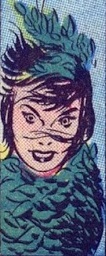
| (Uncanny Tales#42 - BTS) - In 1956, after 6 months
alone in an island lighthouse, an exhausted Matt Ronson fell asleep at his
watch. Apparently observing him from afar, a group of apparent Sirens noted that he was asleep.
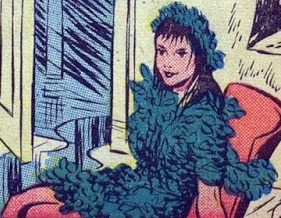
(Uncanny Tales#42) - One of the Sirens knocked
at the door, awakening Ronson, who was shocked to see a woman on the
island. He invited the drenched woman into the lighthouse, but when he
asked who she was, how she got there, etc., she replied only that she
had come to wait there with him.
As storm clouds gathered in the evening sky,
Ronson -- distracted by his beautiful guest -- failed to light the
lightouse's warning beacon. He noted that she was a strange woman and
that he had never seen anyone like her before, but that just hearing
her voice made him feel alive again.
Suspecting rocks from previous maps, an approaching ship sounded
its foghorn, alerting Ronson, but as he prepared to turn on the
lighthouse light, a female instead asked him to stay down with her, telling him that after the
ship crashed on the rocks he and her sisters could plunder the ship for
wealth. Ronson suspected that the women were the Sirens of legend, and
as they approached him, his struggles to get away caused him to knock
over a gas lamp that set fire to the lighthouse. Warned by the fire's
light, the ship reversed engines and was saved.
When the ship docked the next day, the crew
disbelieved Ronson's story of the Sirens, until he showed them a number
of bare foot prints.
| 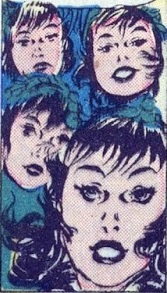
|
|
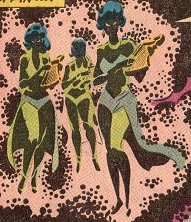 (Sub-Mariner I#29) - Sent by Zeus to force Hercules to return to
Earth, but knowing that Hercules could sense his power/presence and
flee, the Huntsman instead plotted to enlist Namor the Sub-Mariner to
overtake his quarry. As Namor approached, the Huntsman used his staff
to summon (or perhaps instead create facsimilies of) a trio of Sirens.
The green-skinned women then played their lyres and sang, swiftly
entrancing Namor and forcing him to approach. With Namor now under his
command, the Huntsman sent the Sirens back to Olympus (or dispersed his
creations). (Sub-Mariner I#29) - Sent by Zeus to force Hercules to return to
Earth, but knowing that Hercules could sense his power/presence and
flee, the Huntsman instead plotted to enlist Namor the Sub-Mariner to
overtake his quarry. As Namor approached, the Huntsman used his staff
to summon (or perhaps instead create facsimilies of) a trio of Sirens.
The green-skinned women then played their lyres and sang, swiftly
entrancing Namor and forcing him to approach. With Namor now under his
command, the Huntsman sent the Sirens back to Olympus (or dispersed his
creations).
(Sub-Mariner I#29 - BTS) - Namor eventually regained his wits in
battle with Hercules, and he subsequently knocked the Huntsman's staff
of power out of his hands, rendering him powerless and easily subdued
by Hercules.
|
(Ghost Rider II#52 - BTS) - In
recent years, dynamite was used to blow up a boulder that had rolled
down onto the road in front of the cliff containing the Sirens, which
was to be part of the Shelbyville 100-Mile Enduro-Classic motorcycle race.
Feeling that the entire cliff had been shaken by the explosion, Fred
suggested to Al that perhaps he had used too much dynamite, but Al told
Fred he just wanted to be sure.
The explosion knocked askew the lid of Leucosia's sarcophagus.
|
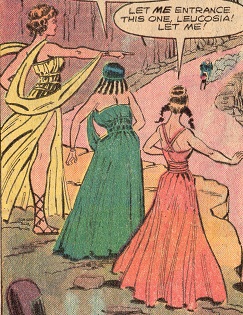 (Ghost Rider II#52) - Leucosia
was elated to be free of her sarcophagus, and she first chose to step
once more into sunlight and express her joy in song. As she sang, a
pair of men were entranced by the song, causing them to wreck their
truck; relatively unharmed they headed up the mountain to follow the
sound. (Ghost Rider II#52) - Leucosia
was elated to be free of her sarcophagus, and she first chose to step
once more into sunlight and express her joy in song. As she sang, a
pair of men were entranced by the song, causing them to wreck their
truck; relatively unharmed they headed up the mountain to follow the
sound.
(Ghost Rider II#52 - BTS) -
Having been told by Fred and Al that they could start the race after
hearing the dynamite blasts, Tim and Jerry started the race; arriving
late, Johnny Blaze took off to try to catch up.
(Ghost Rider II#52) - Unable to lift the massive stone slabs over the sarcophagi holding Ligea and Parthenope, Leucosia
heard the roar of the onrushing cyclists. Though initially marveling at
the gladiators approaching on chariots that bellowed like rolling
thunder, Leucosia resolved that they were men who could help free Ligea and Parthenope. She sang, entrancing the group and causing some of them to crash but all of them to follow the sound of the music.
(Ghost Rider II#52 - BTS) -
Catching up, Blaze came around a corner and couldn't stop before
hitting the downed cycles after slipping on spilled oil. Although he
maneuvered to land his motorcyle upright, he still was knocked out when
his head struck the cliff wall.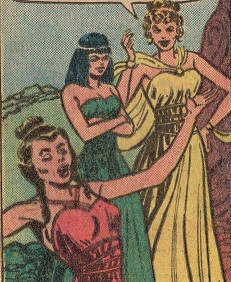
(Ghost Rider II#52) - After the other, ensorceled bikers arrived in the Sirens' cave, Leucosia had them lift the stone slabs off of Ligea, and Parthenope's sarcophagi.
All three Sirens watched as the
recovered Blaze approached them, and -- as they noted that he was more
handsome than the others -- Parthenope asked if she could be the one to entrance him. Leucosia and Ligea agreed, althought Leucosia questioned whether she could still find her voice after all these years, but Parthenope
assured her that her voice had never failed where handsome men were
concerned. As Parthenope sang, Blaze began to fall under her spell but
finally resisted by turning into the Ghost Rider.
As they saw the flaming demon
approaching, Leucosia feared that lord Kronos had divined their escape
and sent forth a demon from out of their own underworld to destroy
them. Sending the entranced bikers against Ghost Rider, the Sirens
converted into avian forms and flew off.
(Ghost Rider II#52 - BTS) -
Not wishing to harm the entranced bikers, Ghost
Rider melted the ground below their cycles, causing them to be stuck,
and then drove up a sheer cliff wall to escape them.
(Ghost Rider II#52) - Several
miles away, the Sirens spotted a US missile convoy headed for San
Jethro for a test firing of the Kronos nuclear missile. Assuming the
soldiers to be associated with their Kronos, the Sirens entranced them
and -- after learning of the missile ability to wipe out a target
radius of up to 250 miles -- then forced them to take them to San
Jethro, planning to use the weapon to destroy a city, believing that
they were using Kronos' weapon to achieve vengeance against Kronos for
their imprisonment of "so many centuries."
(Ghost Rider II#52 - BTS) -
Pursuing the Sirens, Blaze encountered a wrecked command jeep and
learned from its occupants the Sirens' activities and plans.
(Ghost Rider II#52 (fb) - BTS)
- Arriving at San Jethro, the Sirens entranced the guards and staff
there as well, and had the soldiers prepare the missile for launching. |
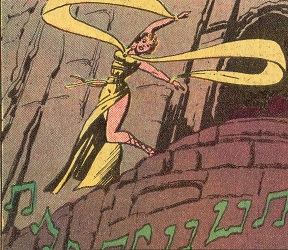 (Ghost Rider II#52 - BTS) - Blaze arrived at San Jethro.
(Ghost Rider II#52 - BTS) - Blaze arrived at San Jethro.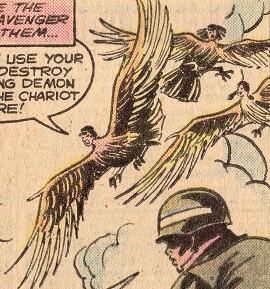
(Ghost Rider II#52) -The Sirens
had the missile launched, intending to strike Albequerque. As Blaze
approached, he turned back into Ghost Rider, and the Sirens,
appreciating the danger, turned into bird-hybrids while exhorting their
mesmerized soldier to kill the flaming demon. After immobilizing the
troops in rings of fire, Ghost Rider rode his motorcyle up the
launching tower. Too late, the Sirens realized Ghost Rider could reach
him, and they attempted to flee, but he caught them each with hellfire
blasts, stunning them, although their wings nonethless allowed them to
glide safely to the ground.
(Ghost Rider II#52 - BTS) - As
Ghost Rider created a flame cycle and navitated his own safe return to
Earth, those within Fort San Jethro's control tower regained their wits
and aborted the missile's flight, causing an explosion that destroyed
the missile, apparently without setting off the nuclear weapon.
(Ghost Rider II#52 (fb) - BTS)
- Ghost Rider brought the Sirens back to the cavern from which they had
escaped and returned them to their sarcophagi.
(Ghost Rider II#52 - BTS) -
Ghost Rider then resealed the sarcophagi with mystic flamed and then
moved a massive sheet of rock to cover the cavern's entrance.
Believing the Sirens would never again be free to threaten mankind, Ghost Rider rode off.
(Agents of Atlas I#5) - Namora revealed Venus' origins as a Siren/Naiad, restoring her memory of her past.
(X-Men vs. Agents of Atlas#2/2) - After revealing Venus to have been created by Phorcys, Aphrodite summoned Phorcys.
(Assault of New Olympus Prologue#1 (fb) - BTS) -
Aphrodite told Phorcys of Venus' existence, and Phorcys compelled Venus
to come to the San Francisco bay.
(Assault of New Olympus Prologue#1) - Phorcys
compelled Venus to sing and compel the people to jump off the bridge
into the water so he could devour them. The Agents of Atlas arrived to
oppose Phorcys.
(Incredible Hercules#138/2) -
After Jimmy Woo broke free from Phorcys' control, the creature
considered that its time was passed, and it sank beneath the waters on
San Francisco.
Comments: Sirens were created by unknown persons (possibly Homer) as part of Graeco-Roman/Olympian mythology.
first adapted into Atlas/Marvel Comics by Bernie Krigstein.
This is a race profile and is not
intended to fully cover the Venus siren, who will get her own
profile...someday!
When Namora first revealed Venus'
origins, she referred to her a "naiad" or "siren." Phorcys also
referred to them as sea nymphs.
The question in my mind is...are
these all the same sirens? Are there more than one type of sirens, or
is there only one true kind of siren, while the others are posers?
According to mythology, there are
two separate origins for the Sirens. The on involves being creations of
Phorcys, while the other has them as daughters of Achelous and one of the Muses (such as Terpsichore, Melpomene, or Calliope)
The OHotMU Olympians entry,
which was written before Phorcys was revealed to be the creator of (at
least some of) the Sirens, said this:
The daughters of Achelous and the divine muse of dance Terpsichore, the immortal Sirens lived on the Sirenum Scopuli Islands and were companions of the goddess Persephone. When Persephone was abducted by Pluto, her mother Demeter (aka Ceres) had the Sirens emit a mesmerizing song to call for her. This “siren song” would later lure
mortal sailors to their watery deaths. Sub-Mariner #29 (1970)
So, I'll have a conclusion at the bottom, but for now, enjoy some various myth interpretations:
Courtesy of www.greekmythology.com/Myths/Creatures/Sirens/sirens.html
Half-birds, half
beautiful maidens, the Sirens were singing enchantresses capable of
luring passing sailors to their islands, and, subsequently, to their
doom. Daughters of the river god Achelous and a Muse, they were fated
to die if anyone should survive their singing. When Odysseus passed
them by unharmed, they hurled themselves into the sea and were drowned.
Sirens Family
Traditionally, the Sirens were daughters of the river god Achelous and
a Muse; it depends on the source which one, but it was undoubtedly one
of these three: Terpsichore, Melpomene, or Calliope. However, according
to the great tragedian Euripides, the Sirens’ mother was actually one
of the Pleiades, Sterope.
In Homer, only two nameless Sirens are mentioned. Later authors usually
talk about three, naming them in any number of ways. It would seem that
Theixiope, Aglaope, and Parthenope are the three names one encounters
with the highest frequency.
Sirens Dwelling Place
In any case, most agree that they lived on three small rocky islands,
called Sirenum scopuli by the Romans. It was said that the Sirens’
dwelling place was a ghastly sight to behold: a great heap of bones lay
all around them, with the flesh of the victims still rotting off the
dead bodies…
Sirens Portrayal
In the “Odyssey,” Homer says nothing about the Sirens’ outward
appearance, but one can infer from the text that he has in mind
humanlike creatures, if not beautiful maidens. However, at a later
date, this all changed and both poets and artists started depicting the
Sirens in a similar fashion to how the Harpies were usually portrayed –
that is, as creatures with the body of a bird and a woman’s face.
The Abduction of Persephone
Quite a few stories tried shedding some light on this transformation,
but the most famous two are related to the abducting of Persephone, to
whom it was said that they had been either servants or companions.
According to the first one, Demeter turned the Sirens into bird-like
monsters because they had failed to help her daughter. The second one
is much more flattering to them: in this case, the aggrieved Sirens
asked Demeter for wings themselves, so that they can help her search
for Persephone better.
Sirens and Odysseus
After Odysseus had made up his mind to leave Aeaea and head back to
Ithaca, the love-stricken Circe had no choice but to let him go.
However, on going away, she warned him of the dangers that yet awaited
him on his journey.
“First you will come to the Sirens,” she told him, “who enchant all who
come near them. If anyone unwarily draws in too close and hears the
singing of the Sirens, his wife and children will never welcome him
home again, for they sit in a green field and warble him to death with
the sweetness of their song.”
There was only one way for a sailor to pass the Sirens unharmed; and
that was by not hearing them sing. So, advised by Circe, Odysseus
ordered each member of his crew to stuff his own ears with beeswax. As
for himself, he opted for a much riskier solution.
Ever the adventurer, he had himself bound to the mast, instructing his
sailors to tie him even tighter if he starts begging them to be
unfastened or tries to break loose by himself. Ever the adventurer,
Odysseus didn’t want to miss the opportunity to experience the luring
song of the Sirens and hear what the fuss is all about.
Sirens and Orpheus
As enchanting as their singing might have been to mortals, the Sirens
seems to have been no match to divine musicians. The Argonauts, for
example, had no problem whatsoever to evade these terrible creatures,
since they had none other than Orpheus on board. The very moment he
heard their voices, the divine poet drew his lyre and started strumming
a tune so loud and lovely that the bewitching song of the Sirens was
instantaneously drowned out.
Truth be told, even a second of the Sirens’ singing was enough to lure
one especially sensitive member of the Argonauts’ crew – a certain
Boutes of Athens – to jump overboard and start swimming towards them.
Fortunately, he was saved by Aphrodite who, subsequently, took him as
her lover and bore him a son, Eryx.
Sirens and The Muses
The Sirens were never more humiliated than when Hera persuaded them to
challenge the Muses to a singing contest. Unsurprisingly, the Muses
won, and, as a punishment, they plucked out the Sirens’ feathers and
used them to make crowns for themselves.
Persephone’s Handmaidens
Before the Sirens became the Sirens, they were mortal girls who served the goddess Persephone.
These lovely girls trailed behind Persephone when she visited her
favorite meadows to pick flowers. They sang to her in sweet voices and
played instruments to please her. When
Persephone was abducted by Hades, the loyal handmaidens volunteered to
help look for her. Demeter gave them golden wings, so that they could
fly over the earth searching for Persephone—but the search was vain,
since Persephone had been imprisoned in the underworld.
Heartbroken over the loss of her daughter, Demeter lashed out against
the innocent handmaidens, who had failed to bring good news back from
their search. She cursed them, declaring that they would stay in their
bird form until someone passed by their songs without stopping, at
which point they would die. Then she banished them to an uninhabited
island.
Competition with the Muses
After
some time, Hera came to visit the Sirens on their lonely island. She
had heard praise for their songs, full of beauty and anguish, and she
was not disappointed by the live performance! So the goddess decided to
give the girls a challenge. She invited them to enter a singing contest
against the nine muses. After
consulting together, the Sirens agreed to enter the contest. Of course,
they had heard of the Muses’ legendary music, but they also knew that
the power of their own songs. The
competition produced some of the most haunting music that the Greeks
had ever heard, with the Sirens pouring all of their arresting
heartache into their music. Still, the Muses—goddesses of music, where
the Sirens were mere mortals—won the competition. To celebrate, they
plucked out the Sirens’ feathers and made crowns for themselves. The
Sirens returned to their island in humiliation.
Voyage of Odysseus
During
his ten-year voyage home, Odysseus passed by the island where the
Sirens lived. Fortunately, he had been warned of their powers ahead of
time, so as his ship drew near the rocky coast, he ordered all of his
sailors to pug their ears with beeswax.Odysseus,
however, was determined to hear the legendary music of the Sirens—and
live to tell the tale. With this goal in mind, he ordered his sailors
to tie him to the mast of his ship. He then gave orders that he should
not be untied, no matter how he begged or threatened them.
The
nervous sailors agreed to tie up their captain. No sooner were the
ropes knotted than Odysseus heard voices, unimaginably high and clear,
calling to him. Odysseus
was, understandably flattered, and he began to wish to meet the
beautiful women who sang so sweetly to him. After a few more lines of
the siren music, Odysseus was in a frenzy to be released. He raved at
his sailors—who, fortunately, could not hear him since their ears were
full of beeswax—and strained at his ropes until they cut into his skin.
But the ship drifted on, and in an hour, the island was behind them and
the spell subsided. After Odysseus passed the island, the Sirens hurled
themselves into the sea and died, making him the last person to hear
their bewitching music.
History
The
Sirens appear in Greek’s oldest works of literature. Homer, Virgil,
Pliny the Elder, Ovid, Seneca, and Hesiod all describe these bewitching
singers. By the end of the Greek period, Grecian scholars had concluded
that the women were no more than fable—yet their legend lived on for
centuries after the Greek civilization crumbled away.
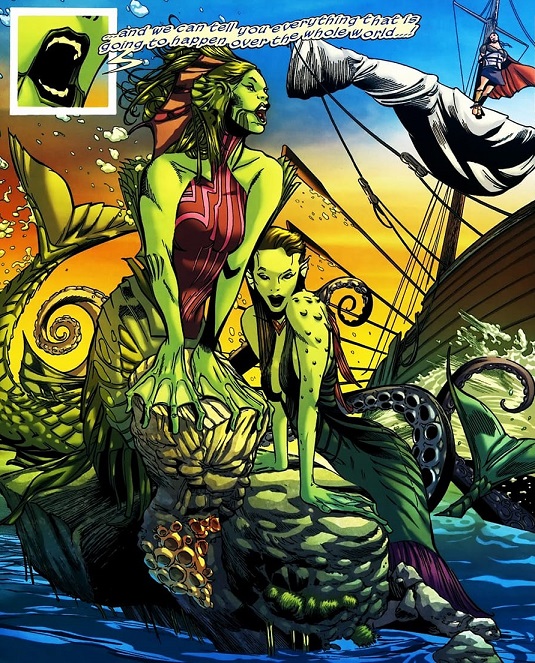
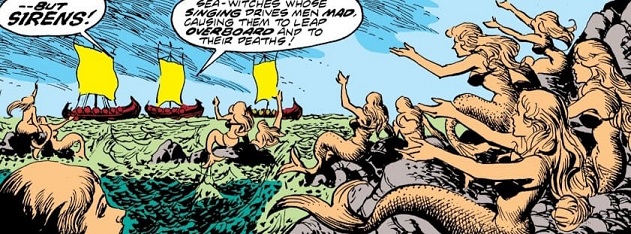
Writers
as far back as William Shakespeare began to merge Sirens with mermaids,
combining the sweet, vibrant appearance of the fish-maidens with the
dreamy voice of the Sirens. Over time, the link between these two
creatures has grown tighten. Today, it’s hard to find a feathered Siren
in popular culture.
Although
the original Sirens have gone out of fashion, Siren-mermaid hybrids are
still incredibly popular. They can be found in all sorts of works of
fantasy, from fairytales written by Hans Christian Anderson and CS
Lewis to blockbuster movies like Harry Potter and Pirates of the Caribbean
Encylopedia Brittanica
Siren, in Greek mythology, a creature
half bird and half woman who lured sailors to destruction by the sweetness of
her song. According to Homer, there were
two Sirens on an island in the western sea between Aeaea and the rocks of Scylla. Later the
number was usually increased to three, and they were located on the west coast
of Italy, near Naples. They were
variously said to be the daughters of the sea god Phorcys or of the river god
Achelous by one of the Muses.
In
Homer’s Odyssey, Book XII,
the Greek hero Odysseus, advised by the sorceress Circe, escaped the
danger of their song by stopping the ears of his crew with wax so that they
were deaf to the Sirens. Odysseus himself wanted to hear their song but had
himself tied to the mast so that he would not be able to steer the ship off its
course. Apollonius of Rhodes, in Argonautica, Book IV,
relates that when the Argonauts sailed
that way, Orpheus sang so
divinely that only one of the Argonauts heard the Sirens’ song. (According to Argonautica, Butes
alone was compelled by the Sirens’ voices to jump into the water, but his life
was saved by the goddess Cypris, a cult name for Aphrodite.) In
Hyginus’s Fabulae,
no. 141, a mortal’s ability to resist them causes the Sirens to commit suicide.
Ovid (Metamorphoses, Book V)
wrote that the Sirens were human companions of Persephone. After she
was carried off by Hades, they sought
her everywhere and finally prayed for wings to fly across the sea. The gods
granted their prayer. In some versions Demeter turned
them into birds to punish them for not guarding Persephone. In art the Sirens
appeared first as birds with the heads of women and later as women, sometimes
winged, with bird legs.
The Sirens seem to have evolved from an ancient tale of the
perils of early exploration combined with an Asian image of a bird-woman.
Anthropologists explain the Asian image as a soul-bird—i.e., a winged ghost
that stole the living to share its fate. In that respect the Sirens had affinities with
the Harpies.
Reviewing the stories themselves and the myth information above, with the two completely
different origins, and the avian vs. piscene natures, draws me to the conclusion that it is
EXTREMELY likely that there were two variants of Sirens in the
Marvel Universe: The more piscene/aquatic Sirens that are the creations
of Phorcys (which would include the versions that encountered Matt
Ronson and likely those summoned/created by the Huntsman, as well as, obviously, Venus the Siren and her ilk) and the avian
Sirens, who were the children of Achelous and a Muse (or Sterope of the
Pleiades), who became avian following their transformation by Demeter,
such as those that were banished by Cronus and who encountered the
Ghost Rider.
Thanks to John Holstein for pointing out the appearance in Uncanny
Tales, and thanks to David A. Zuckerman for supplying me with the color
images!
Thanks to Mike Castle for providing the images from Marvel Classics Comics#18 and The Odyssey#5.
Neither of these are typically "canon"/in-continuity
for Reality-616; however, when they represent the best source of the
historical events, legends, stories, they're at least worthy of
discussion.
This profile was completed 04/09/2021, but its publication was delayed as it was intended for the Appendix 20th anniversary 's celebratory event.
Profile by Snood.
CLARIFICATIONS:
The Sirens should be distinguished from:
- SIRENS of Earth-691 (Skarlet) - able to entrance men, at least--Amazing Adventures II#18
- SIREN - Changelings. wings and bird-legs--Incredible Hulk II#251, 252
- SIREN ( ) -
infant Warpy in cave of James
Lexington Christian, summoned other Warpies to him--Captain Britain II#14/4
- "SIREN" - see Ms. COSTANZA--District X#1
- SIREN of Earth-93060 (Jennifer
Pearson) - Ultraforce, daughter of Eliminator, mutated by Aladdin--Eliminator#1
- SIRYN (Theresa
Rourke) - mutant, Fallen
Angels, X-Force, X-Corps, X-Factor Investigations, daughter of Banshee. sonic powers--Spider-Woman I#37
- other "Siren" characters
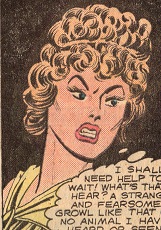 |
(Ghost Rider II#52 (fb) - BTS) - For their "evil trangressions," the Sirens Leucosia,
Ligea, and Parthenope were imprisoned by "Kronos" (aka Cronus and Saturn, the latter of which he was known by to the Romans) within stone sarcophagi and banished to a remote and savage land (outside what would become Shelbyville in the American Southwest) within a sealed cave within a cliff.
(Ghost Rider II#52) - In recent
years, dynamite used to clear a nearby road for a motorcycle race freed
Leucosia from her sarcophagus, and she then ensorceled the bikers to
free Ligea and Parthenope. As John Blaze approached, Parthenope asked
to be allowed to ensorcel him, but he resisted by turning into the
Ghost Rider.
Leucosia feared that lord Kronos had divined their escape
and sent forth a demon from out of their own underworld to destroy
them. Sending the entranced bikers against Ghost Rider, the Sirens
converted into avian forms and flew off.
(Ghost Rider II#52) - Spotting
a US missile convoy headed for San
Jethro for a test firing of the Kronos nuclear missile, the Sirens
ensorceled the soldiers and then planned to use the weapon to destroy
the city of Albequerque, believing that
they were using Kronos' weapon to achieve vengeance against Kronos for
their imprisonment of "so many centuries."
(Ghost Rider II#52) - The
Sirens had the missile launched from Fort San Jethro. When Ghost Rider
arrived they turned into avian form to flee, but he reached them and
incapaciated them with hellfire, after which those within Fort San
Jethro's control tower regained their wits
and aborted the missile's flight, causing an explosion that destroyed
the missile, apparently without setting off the nuclear weapon.
(Ghost Rider II#52 (fb) - BTS)
- Ghost Rider brought the Sirens back to the cavern from which they had
escaped and returned them to their sarcophagi.
(Ghost Rider II#52 - BTS) -
Ghost Rider then resealed the sarcophagi with mystic flamed and then
moved a massive sheet of rock to cover the cavern's entrance.
Believing the Sirens would never again be free to threaten mankind, Ghost Rider rode off.
|
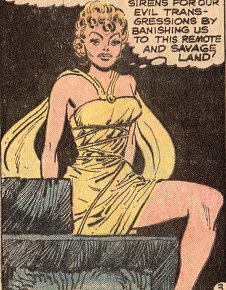
| 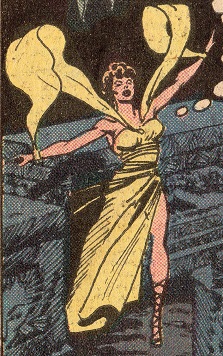 |
 |
(Ghost Rider II#52 (fb) - BTS) - For their "evil trangressions," the Sirens Leucosia,
Ligea, and Parthenope were imprisoned by "Kronos" (aka Cronus and Saturn, the latter of which he was known by to the Romans) within stone sarcophagi and banished to a remote and savage land (outside what would become Shelbyville in the American Southwest) within a sealed cave within a cliff.
(Ghost Rider II#52) - In recent
years, dynamite used to clear a nearby road for a motorcycle race freed
Leucosia from her sarcophagus, and she then ensorceled the bikers to
free Ligea and Parthenope.
As John Blaze approached, Ligea noted how he was much more handsome than the other bikers. Parthenope asked
to be allowed to ensorcel him, but he resisted by turning into the
Ghost Rider.
Leucosia feared that lord Kronos had divined their escape
and sent forth a demon from out of their own underworld to destroy
them. Sending the entranced bikers against Ghost Rider, the Sirens
converted into avian forms and flew off.
(Ghost Rider II#52) - Spotting
a US missile convoy headed for San
Jethro for a test firing of the Kronos nuclear missile, the Sirens
ensorceled the soldiers and then planned to use the weapon to destroy
the city of Albequerque, believing that
they were using Kronos' weapon to achieve vengeance against Kronos for
their imprisonment of "so many centuries."
(Ghost Rider II#52) - The
Sirens had the missile launched from Fort San Jethro. When Ghost Rider
arrived they turned into avian form to flee, but he reached them and
incapaciated them with hellfire, after which those within Fort San
Jethro's control tower regained their wits
and aborted the missile's flight, causing an explosion that destroyed
the missile, apparently without setting off the nuclear weapon.
(Ghost Rider II#52 (fb) - BTS)
- Ghost Rider brought the Sirens back to the cavern from which they had
escaped and returned them to their sarcophagi.
(Ghost Rider II#52 - BTS) -
Ghost Rider then resealed the sarcophagi with mystic flamed and then
moved a massive sheet of rock to cover the cavern's entrance.
Believing the Sirens would never again be free to threaten mankind, Ghost Rider rode off.
|
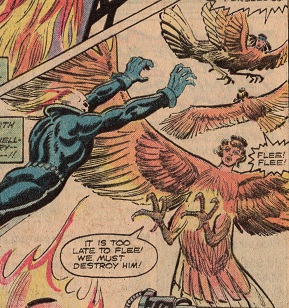
| 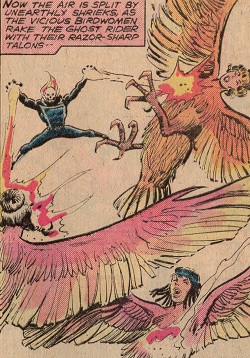 |
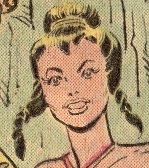 |
(Ghost Rider II#52 (fb) - BTS) - For their "evil trangressions," the Sirens Leucosia,
Ligea, and Parthenope were imprisoned by "Kronos" (aka Cronus and Saturn, the latter of which he was known by to the Romans) within stone sarcophagi and banished to a remote and savage land (outside what would become Shelbyville in the American Southwest) within a sealed cave within a cliff.
(Ghost Rider II#52) - In recent
years, dynamite used to clear a nearby road for a motorcycle race freed
Leucosia from her sarcophagus, and she then ensorceled the bikers to
free Ligea and Parthenope.
As John Blaze approached, Parthenope asked
to be allowed to ensorcel him, but he resisted by turning into the
Ghost Rider.
Leucosia feared that lord Kronos had divined their escape
and sent forth a demon from out of their own underworld to destroy
them. Sending the entranced bikers against Ghost Rider, the Sirens
converted into avian forms and flew off.
(Ghost Rider II#52) - Spotting
a US missile convoy headed for San
Jethro for a test firing of the Kronos nuclear missile, the Sirens
ensorceled the soldiers and then planned to use the weapon to destroy
the city of Albequerque, believing that
they were using Kronos' weapon to achieve vengeance against Kronos for
their imprisonment of "so many centuries."
(Ghost Rider II#52) - The
Sirens had the missile launched from Fort San Jethro. When Ghost Rider
arrived they turned into avian form to flee, but he reached them and
incapaciated them with hellfire, after which those within Fort San
Jethro's control tower regained their wits
and aborted the missile's flight, causing an explosion that destroyed
the missile, apparently without setting off the nuclear weapon.
(Ghost Rider II#52 (fb) - BTS)
- Ghost Rider brought the Sirens back to the cavern from which they had
escaped and returned them to their sarcophagi.
(Ghost Rider II#52 - BTS) -
Ghost Rider then resealed the sarcophagi with mystic flamed and then
moved a massive sheet of rock to cover the cavern's entrance.
Believing the Sirens would never again be free to threaten mankind, Ghost Rider rode off.
|
|
sarcophagi
|
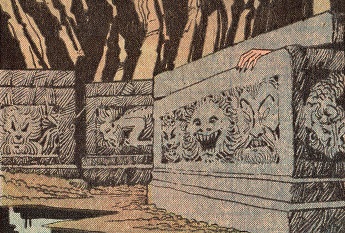 (Ghost Rider II#52 (fb) - BTS) - For their "evil trangressions," the Sirens Leucosia,
Ligea, and Parthenope were imprisoned by "Kronos" (aka Cronus and Saturn, the latter of which he was known by to the Romans) within stone sarcophagi and banished to a remote and savage land (outside what would become Shelbyville in the American Southwest) within a sealed cave within a cliff. (Ghost Rider II#52 (fb) - BTS) - For their "evil trangressions," the Sirens Leucosia,
Ligea, and Parthenope were imprisoned by "Kronos" (aka Cronus and Saturn, the latter of which he was known by to the Romans) within stone sarcophagi and banished to a remote and savage land (outside what would become Shelbyville in the American Southwest) within a sealed cave within a cliff.
(Ghost Rider II#52) - In recent
years, dynamite used to clear a nearby road for a motorcycle race freed
Leucosia from her sarcophagus. Unable to lift the lids off of the other sarcophagi, she then ensorceled the bikers to
free Ligea and Parthenope.
(Ghost Rider II#52 (fb) - BTS)
- After defeating the Sirens, Ghost Rider brought them back to the cavern from which they had
escaped and returned them to their sarcophagi.
(Ghost Rider II#52 - BTS) -
Ghost Rider then resealed the sarcophagi with mystic flamed and then
moved a massive sheet of rock to cover the cavern's entrance.
| 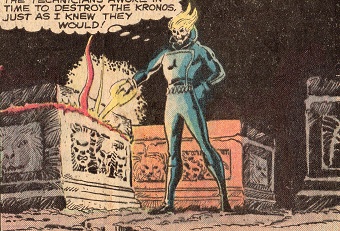
| 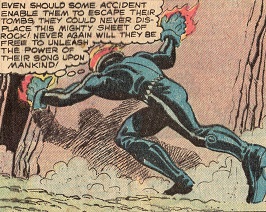
|
images: (without ads)
Uncanny Tales I#42/1, pg. 4, panel 4 (full, feathery forms);
panel 5 (faces)
Sub-Mariner I#29, pg. 4, panel 1 (Huntsman summoning Sirens; full, shadowed);
panel 2 (upper bodies with lyres);
Marvel Classics Comics#18, pg. 26, panel 2 (mermaid sirens)
Ghost Rider II#52, pg. 3, panel 4 (sarcophagi with Leucosia's hand);
panel 5 (Leucosia emerging);
pg. 4, panel 1 (Leucosia; full, standing);
panel 2 (Leucosia dancing);
pg. 6, panel 3 (Leucosia face);
pg. 10, panel 3 (three, full, mostly posterior view);
panel 5 (Parthenope, face);
pg. 12, panel 3 (Ligea, face);
pg. 14, panel 2 (three, upper);
pg. 18, panel 1 (avian form close-up);
panel 2 (distant);
pg. 19, panel 3 (confronted by Ghost Rider);
pg. 20, panel 1 (hellfire);
pg. 22, panel 2 (Ghost Rider sealing sarcophagi);
panel 4 (closing rock over cave)
The Odyssey#5, pg. 15, panel 1 (mermaid sirens)
Agents of Atlas I#5, pg. , panel 1 (original form of future Venus)
Appearances:
Uncanny Tales I#42/1 (April, 1956) - Bernie Krigstein (story and art)
Sub-Mariner I#29 (September, 1970) - Roy Thomas (writer), Sal Buscema (penciler), Joe Gaudioso (inker), Stan Lee (editor)
Marvel Classics Comics#18 (June, 1976) - Bill Mantlo (writer), Jess Jodloman (artist),
Ghost Rider II#52 (January, 1981) - Michael Fleisher (writer), Don Perlin (artist), Denny O'Neil (editor)
Agents of Atlas I#5 (February, 2007) - Jeff Parker (writer), Leonard
Kirk (penciler), Kris Justice (inker), Nathan Cosby (assistant editor),
Mark Paniccia (editor)
Marvel
Tarot (August, 2007) - David Sexton (writer/designer), Doug Sexton (technical
consultant), Jeff Christiansen (continuity consultant), Michael Short
& Cory Levine (assistant editors), Mark D. Beazley & Jennifer
Grunwald (associate editors), Jeff Youngquist (editor)
The Odyssey#5 (March, 2009) - Roy Thomas (writer), Greg Tocchini
(penciler), Norman Lee & Roland Paris (inkers), Nathan Cosby
(assistant editor), Ralph Macchio (editor)
Official Handbook of the Marvel Universe A to
Z#12: Venus (Siren) (2010) - Jeff Christiansen (head writer), Mike
Fichera, Markus Raymond, Mike O'Sullivan, & Madison Carter
(writers, coordination assistants), Sean McQuaid (profile writer)
X-Men vs. Agents of Atlas#2 (January, 2010) - Jeff Parker (writer), Gabriel Hardman (artist), Mark Paniccia (editor)
Assault of New Olympus Prologue#1 (January, 2010) - Jeff Parker (writer), Gabriel Hardman (artist), Mark Paniccia (editor)
Incredible Hercules#138/2 (January, 2010) - Jeff Parker (writer), Gabriel Hardman (artist), Mark Paniccia (editor)
First posted: 09/06/2021
Last updated: 09/04/2021
Any Additions/Corrections? please let me know.
Non-Marvel Copyright info
All other characters mentioned or pictured are ™ and
© 1941-2099 Marvel Characters, Inc. All Rights Reserved. If you
like this stuff, you should check out the real thing!
Please visit The Marvel Official Site at: http://www.marvel.com
Special Thanks to
www.g-mart.com for hosting the Appendix, Master List, etc.!
Back to Races







 (Sub-Mariner I#29) - Sent by Zeus to force Hercules to return to
Earth, but knowing that Hercules could sense his power/presence and
flee, the Huntsman instead plotted to enlist Namor the Sub-Mariner to
overtake his quarry. As Namor approached, the Huntsman used his staff
to summon (or perhaps instead create facsimilies of) a trio of Sirens.
The green-skinned women then played their lyres and sang, swiftly
entrancing Namor and forcing him to approach. With Namor now under his
command, the Huntsman sent the Sirens back to Olympus (or dispersed his
creations).
(Sub-Mariner I#29) - Sent by Zeus to force Hercules to return to
Earth, but knowing that Hercules could sense his power/presence and
flee, the Huntsman instead plotted to enlist Namor the Sub-Mariner to
overtake his quarry. As Namor approached, the Huntsman used his staff
to summon (or perhaps instead create facsimilies of) a trio of Sirens.
The green-skinned women then played their lyres and sang, swiftly
entrancing Namor and forcing him to approach. With Namor now under his
command, the Huntsman sent the Sirens back to Olympus (or dispersed his
creations). (Ghost Rider II#52) - Leucosia
was elated to be free of her sarcophagus, and she first chose to step
once more into sunlight and express her joy in song. As she sang, a
pair of men were entranced by the song, causing them to wreck their
truck; relatively unharmed they headed up the mountain to follow the
sound.
(Ghost Rider II#52) - Leucosia
was elated to be free of her sarcophagus, and she first chose to step
once more into sunlight and express her joy in song. As she sang, a
pair of men were entranced by the song, causing them to wreck their
truck; relatively unharmed they headed up the mountain to follow the
sound. 
 (Ghost Rider II#52 - BTS) - Blaze arrived at San Jethro.
(Ghost Rider II#52 - BTS) - Blaze arrived at San Jethro.









 (Ghost Rider II#52 (fb) - BTS) - For their "evil trangressions," the Sirens Leucosia,
Ligea, and Parthenope were imprisoned by "Kronos" (aka Cronus and Saturn, the latter of which he was known by to the Romans) within stone sarcophagi and banished to a remote and savage land (outside what would become Shelbyville in the American Southwest) within a sealed cave within a cliff.
(Ghost Rider II#52 (fb) - BTS) - For their "evil trangressions," the Sirens Leucosia,
Ligea, and Parthenope were imprisoned by "Kronos" (aka Cronus and Saturn, the latter of which he was known by to the Romans) within stone sarcophagi and banished to a remote and savage land (outside what would become Shelbyville in the American Southwest) within a sealed cave within a cliff.
